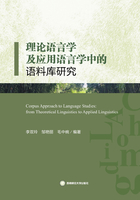
3. Methodology
1)The COCA
This research would study data collected from the COCA which is the only large and balanced corpus of American English. As the most widely-used corpus of English, the COCA contains more than 560 million words of text and includes various genres. Written texts and the transcriptions of recorded speech stored in the COCA, spanning over a quarter-century, can offer unparalleled insight into variation in English and is helpful to carry out a study on huge corpora of millions words. These language samples selected from the COCA would be more objective, reliable and authentic than subjective examples and be the most nature presentation to explore the usage of the grammar, pragmatic and semantic of sentences among native speakers.
2)Research procedure
This research was conducted in two main stages:finding out the most significant static verbs used in the progressive aspect(step 1 and step 2)and analyzing samples with their certain contexts (step 3). In order to narrow the selection, the classification of static verbs would be further interpreted before moving into the step 1.
According to lexical meaning, the static verbs could be further divided into four types:verbs of emotion(e.g. love, hate), verbs of sensation and perception(e.g. feel, touch, hear), verbs of denoting state or relations(e.g. stand, cost, be, belong), verbs of cognition or mental attitude (e.g. believe, think, hope)(Bo,1992). This classification of static verbs would be adopted in this article, though static verbs could be reasonably classified in numerous ways depending on different dimension. Eight words were selected from four different types of the static verbs and each type of the static verbs had two words associated with it.
Step 1:Eight word groups which contained the static verbs used in the progressive aspect were picked from the top 500 word groups with the highest frequency containing the lemma be and another verb in the form of V-ing in the COCA. Two out of eight words belong to verbs of sensation and perception:see and feel. Two out of eight words belong to verbs of denoting state or relations:be and have. Two out of eight words belong to verbs of cognition or mental attitude:think and wonder. Two out of eight words belong to verbs of emotion:love and worry.
Step 2:These word groups(e.g. be being)would be further analyzed to make sense of their semantic meaning by investigating concordances and contexts. Considering the possibility of the adverbs, one asterisk key was added which represented the adverb between the lemma of be and the static verb in the COCA. In general,800 samples would be further studied with each word group consisting 100 concordance lines, provided that there was no any grammatical mistakes in these samples. The sample using the static verb in wrong way or for wrong purpose would be replaced by another sample.
Step 3:Finally, main functions of static verbs used in the progressive aspect were classified through investigating the semantic meaning and contextual meaning of overall samples. In addition, the distribution of the functions of static verbs in the total samples and the relationship between the data of the functions and subtypes of the static verbs would be discussed.